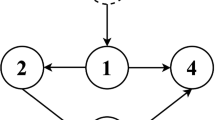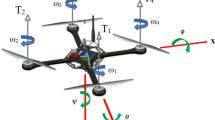Abstract
In this paper, a novel control approach, the state-dependent robust model reference adaptive controller, is presented for a broad class of nonlinear systems with unknown parameters and matched uncertainties. At first, the well-known model reference adaptive control (MRAC) is designed for the system by considering the pseudo-linearized description, making it possible to deal with a broad category of nonlinear systems with unknown parameters without linearization. Also, state-dependent matrices are used to calculate time-varying gains, which extends the domain of the controller. In many cases, the fast adaptation of parameters using the MRAC technique may result in undesired oscillations in the control law and system states. Then, the robust controller is designed to increase the robustness of the system against these oscillations. The error feedback signal is included in the system state equations as a control input to decrease the amplitude of oscillations by solving a series of arisen state-dependent linear matrix inequalities. The main contribution of this paper, rather than some of the other proposed robust MRAC controllers, is that it covers a broad class of nonlinear systems. Finally, to demonstrate the effectiveness of the proposed technique in terms of convergence rate, accuracy, and robustness in the reference trajectory tracking, it is applied to Genesio chaotic system having unknown parameters.














Similar content being viewed by others
References
Albertos P, Antonio S (2006) Multivariable control systems: an engineering approach. Springer Science and Business Media, Berlin
Batmani Y (2017) Blood glucose concentration control for type 1 diabetic patients: a non-linear suboptimal approach. IET Syst Biol 11(4):119–125
Batmani Y, Davoodi M, Meskin N (2016) Nonlinear suboptimal tracking controller design using state-dependent Riccati equation technique. IEEE Trans Control Syst Technol 25(5):1833–1839
Batmani Y, Khaloozadeh H (2016) On the design of suboptimal sliding manifold for a class of nonlinear uncertain time-delay systems. Int J Syst Sci 47(11):2543–2552
Bavarsad A, Fakharian A, Menhaj MB (2020) Optimal sliding mode controller for an active transfemoral prosthesis using state-dependent Riccati equation approach. Arab J Sci Eng 45(8):6559–6572
Cao S, Li Y (2012). The pseudo-linearization and any order approximate analytical solutions for nonlinear dynamical equation. IEEE, pp 54–58
Chakrabarty AK, Bhattacharya S (2010). Robust model reference adaptive controller for single variable non-linear plants. IEEE, pp 1–5
Çimen T (2008) State-dependent Riccati equation (SDRE) control: a survey. IFAC Proc Vol 41(2):3761–3775
Çimen T (2010) Systematic and effective design of nonlinear feedback controllers via the state-dependent Riccati equation (SDRE) method. Annu Rev Control 34(1):32–51
Çimen T (2012) Survey of state-dependent Riccati equation in nonlinear optimal feedback control synthesis. J Guid Control Dyn 35(4):1025–1047
Çimen T, Banks SP (2004) Nonlinear optimal tracking control with application to super-tankers for autopilot design. Automatica 40(11):1845–1863
Cloutier J.R (1997) State-dependent Riccati equation techniques: an overview. In: Proceedings of the 1997 American control conference (Cat. No. 97CH36041), pp 932–936. IEEE
Eugene L, Kevin W, Howe D (2013) Robust and adaptive control with aerospace applications. Springer, London
Fakharian A, Hamidi Beheshti MT (2010) Solving linear and nonlinear optimal control problem using modified adomian decomposition method. J Comput Robot 1(1)
Han J, Yu S, Yi S (2019) Oxygen excess ratio control for proton exchange membrane fuel cell using model reference adaptive control. Int J Hydrog Energy 44(33):18425–18437
Hua C, Guan X, Shi P (2006) Decentralized robust model reference adaptive control for interconnected time-delay systems. J Comput Appl Math 193(2):383–396
Ioannou PA, Sun J (2012) Robust adaptive control. Courier Corporation
Jin L, Chen G (2007) A parallel robust model reference control method based on neural network. In: 2007 IEEE international conference on control and automation, pp 1377–1380. IEEE
Kalamian N, Khaloozadeh H, Ayati M (2019) Design of state-dependent impulsive observer for non-linear time-delay systems. IET Control Theory Appl 13(18):3155–3163
Kalamian N, Khaloozadeh H, Ayati SM (2020) Adaptive state-dependent impulsive observer design for nonlinear deterministic and stochastic dynamics with time-delays. ISA Trans 98:87–100
Kalamian N, Khaloozadeh H, Ayati M (2017) State-dependent impulsive observer design for nonlinear time-delay systems. In: 2017 5th international conference on control, instrumentation, and automation (ICCIA), pp 183–188. IEEE
Kalamian N, Khaloozadeh H, Ayati M (2019). Design of adaptive state-dependent impulsive observer for nonlinear time-delay systems. IEEE, pp 885–890
Kang S, Wu H, Yang X, Li Y, Pan L, Chen B (2021) Fractional robust adaptive decoupled control for attenuating creep, hysteresis and cross coupling in a parallel piezostage. Mech Syst Signal Process 159:107764
Khlaief A, Boussak M, Chaari A (2014) A MRAS-based stator resistance and speed estimation for sensorless vector controlled IPMSM drive. Electr Power Syst Res 108:1–15
Korayem MH, Nekoo S (2015) State-dependent differential Riccati equation to track control of time-varying systems with state and control nonlinearities. ISA Trans 57:117–135
Korayem MH, Nekoo SR (2016) The SDRE control of mobile base cooperative manipulators: collision free path planning and moving obstacle avoidance. Robot Auton Syst 86:86–105
Li X, Li S (2014) Speed control for a PMSM servo system using model reference adaptive control and an extended state observer. J Power Electr 14(3):549–563
Liu Q, Thul A, Hameyer K (2014). A robust model reference adaptive controller for the PMSM drive system with torque estimation and compensation. IEEE, pp 665–671
Maity A, Höcht L, Holzapfel F (2019) Time-varying parameter model reference adaptive control and its application to aircraft. Eur J Control 50:161–175
Maleki N, Sedigh AK, Labibi B (2006) Robust model reference adaptive control of active suspension system. In: 2006 14th mediterranean conference on control and automation, pp 1–6. IEEE
Min-an T, Xiao-Ming W, Jie C, Li C (2017). On lyapunov stability theory for model reference adaptive control. IEEE, pp 1055–1060
Monfared MN, Fakharian A, Menhaj MB (2021) A new modified polynomial-based optimal control design approach. Proc Inst Mech Eng Part I J Syst Control Eng 235(3):355–370
Monfared MN, Fakharian A, Menhaj MB, Abbasi R (2020) Optimal control of immunogenic tumor cells population growth. J Control Eng Appl Inf 22(3):5–12
Najafi A, Spencer BF Jr (2019) Adaptive model reference control method for real-time hybrid simulation. Mech Syst Signal Process 132:183–193
Narendra KS, Annaswamy AM (1986) Robust adaptive control. Adaptive and learning systems. pp 3–31, Springer, Berlin
Nasiri N, Fakharian A, Menhaj MB (2020) Observer-based robust control for flexible-joint robot manipulators: A state-dependent Riccati equation-based approach. Trans Inst Meas Control 42(16):3135–3155
Nazari Monfared M, Yazdanpanah M (2014) Friction compensation for dynamic and static models using nonlinear adaptive optimal technique. AUT J Model Simul 46(1):1–10
Nekoo SR (2019) Model reference adaptive state-dependent Riccati equation control of nonlinear uncertain systems: Regulation and tracking of free-floating space manipulators. Aerosp Sci Technol 84:348–360
Rajpurohit T, Haddad WM, Yucelen T (2016) Output feedback adaptive control with low-frequency learning and fast adaptation. J Guid Control Dyn 39(1):16–31
Saad NH, El-Sattar AA, Gad MA (2016). Sensorless field oriented control based on improved MRAS speed observer for permanent magnet synchronous motor drive. IEEE, pp 991–998
Sarhadi P, Noei AR, Khosravi A (2016) Model reference adaptive PID control with anti-windup compensator for an autonomous underwater vehicle. Robot Auton Syst 83:87–93
Scherer CW (1990) The Riccati inequality and state-space H-infinity-optimal control. Julius Maximilians University Würzburg, Germany
Shadi R, Liavoli FB, Fakharian A (2021). Nonlinear sub-optimal controller for ebola virus disease: state-dependent riccati equation approach. IEEE, pp 1–6
Shi Z, Zhao L (2017) Robust model reference adaptive control based on linear matrix inequality. Aerosp Sci Technol 66:152–159
Siddique AB, Munsi MS, Sarker SK, Das SK, Islam MR (2019) Voltage and current control augmentation of islanded microgrid using multifunction model reference modified adaptive PID controller. Int J Electr Power Energy Syst 113:492–501
Subramanian RG, Elumalai VK, Karuppusamy S, Canchi VK (2017) Uniform ultimate bounded robust model reference adaptive PID control scheme for visual servoing. J Franklin Inst 354(4):1741–1758
Xie J, Yang D, Zhao J (2019) Composite anti-disturbance model reference adaptive control for switched systems. Inf Sci 485:71–86
Xie J, Zhao J (2018) H-infinity model reference adaptive control for switched systems based on the switched closed-loop reference model. Nonlinear Anal Hybrid Syst 27:92–106
Xie X, Wu Z, Wang Q (2004) Performance analysis in robust model reference adaptive control with unknown high frequency gain. In: Fifth world congress on intelligent control and automation (IEEE Cat. No. 04EX788), pp 511–514. IEEE
Yau H-T, Chen C-L (2006) Chattering-free fuzzy sliding-mode control strategy for uncertain chaotic systems. Chaos Solitons Fract 30(3):709–718
Yucelen T, Haddad WM (2012) Low-frequency learning and fast adaptation in model reference adaptive control. IEEE Trans Autom Control 58(4):1080–1085
Zhang D, Wei B (2017) A review on model reference adaptive control of robotic manipulators. Annu Rev Control 43:188–198
Author information
Authors and Affiliations
Corresponding author
Appendix
Appendix
More details about the proof of stability of the Lyapunov function in Theorem 1 and the procedure of obtaining (21) from (20) is as following:
according to proposition 5 the derivative of \(\theta\) is equal to zero, so we have:
also by considering (43) and (44) corresponding (13) and (16)
and the fact that \(trace\left( x{{y}^{T}} \right) ={{x}^{T}}y\), we would have
Finally
Also, the same procedure could be followed for the derivative of Lyapunov function (30) in Theorem 2.
Rights and permissions
About this article
Cite this article
Kamalifar, A., Menhaj, M.B., Monfared, M.N. et al. Design of Robust Model Reference Adaptive Controller for a Wider Class of Nonlinear Systems. Iran J Sci Technol Trans Electr Eng 46, 127–139 (2022). https://doi.org/10.1007/s40998-021-00451-8
Received:
Accepted:
Published:
Issue Date:
DOI: https://doi.org/10.1007/s40998-021-00451-8




